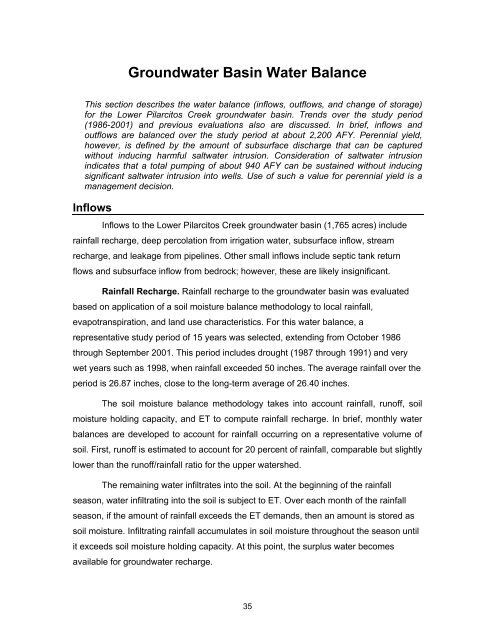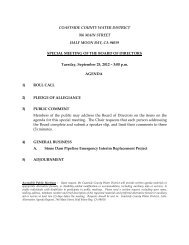Lower Pilarcitos Creek Groundwater Basin Study - Coastside ...
Lower Pilarcitos Creek Groundwater Basin Study - Coastside ...
Lower Pilarcitos Creek Groundwater Basin Study - Coastside ...
Create successful ePaper yourself
Turn your PDF publications into a flip-book with our unique Google optimized e-Paper software.
<strong>Groundwater</strong> <strong>Basin</strong> Water Balance<br />
This section describes the water balance (inflows, outflows, and change of storage)<br />
for the <strong>Lower</strong> <strong>Pilarcitos</strong> <strong>Creek</strong> groundwater basin. Trends over the study period<br />
(1986-2001) and previous evaluations also are discussed. In brief, inflows and<br />
outflows are balanced over the study period at about 2,200 AFY. Perennial yield,<br />
however, is defined by the amount of subsurface discharge that can be captured<br />
without inducing harmful saltwater intrusion. Consideration of saltwater intrusion<br />
indicates that a total pumping of about 940 AFY can be sustained without inducing<br />
significant saltwater intrusion into wells. Use of such a value for perennial yield is a<br />
management decision.<br />
Inflows<br />
Inflows to the <strong>Lower</strong> <strong>Pilarcitos</strong> <strong>Creek</strong> groundwater basin (1,765 acres) include<br />
rainfall recharge, deep percolation from irrigation water, subsurface inflow, stream<br />
recharge, and leakage from pipelines. Other small inflows include septic tank return<br />
flows and subsurface inflow from bedrock; however, these are likely insignificant.<br />
Rainfall Recharge. Rainfall recharge to the groundwater basin was evaluated<br />
based on application of a soil moisture balance methodology to local rainfall,<br />
evapotranspiration, and land use characteristics. For this water balance, a<br />
representative study period of 15 years was selected, extending from October 1986<br />
through September 2001. This period includes drought (1987 through 1991) and very<br />
wet years such as 1998, when rainfall exceeded 50 inches. The average rainfall over the<br />
period is 26.87 inches, close to the long-term average of 26.40 inches.<br />
The soil moisture balance methodology takes into account rainfall, runoff, soil<br />
moisture holding capacity, and ET to compute rainfall recharge. In brief, monthly water<br />
balances are developed to account for rainfall occurring on a representative volume of<br />
soil. First, runoff is estimated to account for 20 percent of rainfall, comparable but slightly<br />
lower than the runoff/rainfall ratio for the upper watershed.<br />
The remaining water infiltrates into the soil. At the beginning of the rainfall<br />
season, water infiltrating into the soil is subject to ET. Over each month of the rainfall<br />
season, if the amount of rainfall exceeds the ET demands, then an amount is stored as<br />
soil moisture. Infiltrating rainfall accumulates in soil moisture throughout the season until<br />
it exceeds soil moisture holding capacity. At this point, the surplus water becomes<br />
available for groundwater recharge.<br />
35



